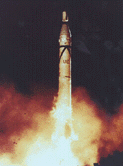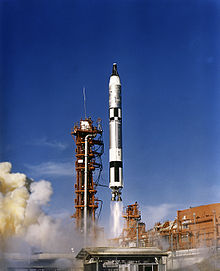White Sands
White Sands
It was the U.S. Army's White Sands Missile Range in New Mexico, where rocket test flights continued after World War II.
 The V-2 rocket |
The
Army
brought the V-2 missile parts captured in Germany for
its Project Hermes missile development program,
managed by General Electric. Wernher von Braun and his
team were housed at nearby Fort Bliss, Texas. From the spring of 1946 up to the fall of 1952, 67 V-2 rockets were launched. The use of these rockets launched the United States into the Space Age in the end. Post-war American liquid fueled rocket engines built later evolved directly from the German engine that powered the V-2. In 1953 the first Redstone rocket was launched for the Army. Around 1950 the Army's missile program was tranferred to a place outside Huntsville, Alabama, launch operations moved to Cape Canaveral in Florida. The Cold War between the U.S. and the U.S.S.R. provided the necessary financial background, not for going into space but for work on intercontinental strategic missiles. Wenher von Braun had to learn this in a conversation with President Dwight D. Eisenhower in the mid-fifties. |
 The Viking rocket |
Competing Forces
The Navy's Viking program followed the V-2 experiments. The Naval
Research Laboratory's Project Vanguard was to be based upon that
rocket and available upper stages (four stages in all) in 1955.
The Vanguard program was only trying to launch one and only one
satellite for scientific purposes.. They also wanted to conduct one
experiment
successfully sometime during the International Geophysical Year
(the 18-month "year" from January 1957 to July 1958). It was in
the times of the Cold War and Vanguard wasn't given the least
military priority. The Vanguard team had to struggle and fight for
money, range time at the Cape, any kind of support in any way.
The entire program was planned for 14 launch vehicles, not all of
those "satellite launch vehicles."
The Air Force proposed a combination called World Series based on an Atlas carrying as its upper stage the well proven Aerobee-Hi space probe rocket.
The Army proposed Project Orbiter (which had been a joint
submission with the Navy first), using the Redstone
missile plus upper stages of Loki rockets.
The Army Ballistic Missile Agency incorporated the Von Braun team
in key positions with Dr. Von Braun as head of the Development
Operations Division.
A decision in favor of the Vanguard program was made in 1955 in the month of August. President Eisenhower had made up his mind not to let scientists use a military intercontinental rocket. Even though the Air Force space effort, considered as a back-up system, was on a sound technical foundation, Pentagon officials didn't like it and adequate funding was lacking.
On October 4, 1957, the nation was shocked when the Russians
launched Sputnik, the world's first artificial satellite. Two
months later, the United States suffered disappointment when a
Navy Vanguard rocket, with its satellite payload, failed
to develop enough thrust, thus toppled over on the launch pad.
 |
Due to their foresight in planning and preparation, the
Von Braun team with the Army Ballistic Missile Agency was
ready when the United States turned to the Huntsville
group to launch America's first satellite in a couple of
weeks. In January 1958, a modified Redstone rocket named
Jupiter-C carried America's first satellite Explorer I
into orbit.
It was not before the Navy's Vanguard 2, had a successful launch. |
NASA
 |
On October 1, 1958 NASA - the National Aeronautics and Space Administration - began operations as the successor to NACA - the National Advisory Committee for Aeronautics. It owned three major research laboratories - Langley Aeronautical Laboratory, Ames Aeronautical Laboratory, and Lewis Flight Propulsion Laboratory - and two smaller test facilities. |
| . |
Project Mercury started on October 7, 1958. Its goal was to send
an astronaut into space in a space capsule that would protect him
from the temperature extremes, vacuum and the recently discovered
radiation belts around the planet. Also had it to keep an
astronaut cool during the flaming high-speed reentry phase into
the atmosphere on its way back. Thus it had to have an ablative
heat shield that burned off as Mercury returned to Earth.
Mercury capsules rode into space on two different kinds of
booster. The first suborbital flights were launched on Redstone
rockets designed by Wernher von Braun's team. For orbital flights,
the Mercury capsule was placed on top of an Atlas-D, a modified
ballistic missile whose steel skin was so thin (in order to save
weight) it would have collapsed like a bag if not pressurized from
within.
 - - |
There were six Mercury flights. The first manned flight took place on May 5, 1961. It was astronaut Alan B. Shepard, Jr.whose Freedom 7 Mercury spacecraft was launched to an altitude of 115 nautical miles and a range of 302 miles in a fifteen-minute suborbital flight. Shepard was the second human and the first American to fly in space after Soviet cosmonaut Yuri Gagarin who had circled the Earth once on April 12, 1961. |
 |
On February 20, 1962, Astronaut John H. Glenn became the first American to circle the Earth, making three orbits in his Friendship 7 Mercury spacecraft. |
Gemini
 |
The Gemini project
was announced to the public on January 3, l962,
Apollo being well underway already. Its primary goal was
to demonstrate space rendezvous and docking-techniques
that would be used during Apollo. Gemini also was to
extend astronauts' stays in space to up to two weeks,
thus making space flight to become routine. Ten piloted missions left the launch pads of Cape Canaveral, Florida, in less than 20 months in 1965 and 1966 after unmanned testing in 1964. The Manned Spacecraft Center (renamed the Johnson Space Center in 1973) outside Houston, Texas, took over the role of Mission Control. Gemini rode into orbit on a Titan 2 launch vehicle. The target for rendezvous operations was an unmanned Agena upper stage, which was launched ahead of the Gemini. Gemini weighed more than 3,628.72 kilograms - twice the weight of Mercury - but having only 50 percent more cabin space for two people. The capsule needed real maneuvering capability to rendezvous with another spacecraft, moving forward, backward and sideways in its orbital path, even changing orbits. Thus two people were needed on board. It also required the first onboard computers to calculate those complicated rendezvous maneuvers. On March 23, 1965, Virgil 'Gus' Grissom and John W. Young became the first to demonstrate their ability to change their craft's orbit with Gemini III. |
 |
The
second piloted Gemini mission, Gemini IV (James McDivitt
and Edward H. White, II), lasted for four days, June 3 -
June7,1965, and astronaut Edward H. White II (see caption)
performed the first spacewalk by an American. The Gemini V mission with L. Gordon Cooper and Charles 'Pete' Conrad lasted longer than seven days (August 21 - August 29, 1965). On Gemini VI-A (Walter M. Schirra, Jr. / Thomas P. Stafford, December 15 - December 16, 1965), Command Pilot Wally Schirra achieved the first space rendezvous with Gemini VII, accurately matching his orbit to that of the other craft, Gemini VII, station-keeping at distances as close as 1 foot (0.30 m) for three consecutive orbits Gemini VII also set a human spaceflight endurance record of fourteen days for Frank Borman and James A. Lovell (December 4 - December 18, 1965). The following mission, Gemini VIII (March 16 - March 17, 1966) with Neil A. Armstrong and David R. Scott, Command Pilot Neil Armstrong achieved the first docking between two spacecraft, his Gemini craft and an Agena target vehicle. The Gemini XI mission (Charles 'Pete' Conrad / Richard F. Gordon, Jr., September 12 - September 15, 1966), commanded by Conrad, achieved the first direct-ascent rendezvous with its Agena target on the first orbit, and used the Agena's rocket to achieve an apogee of 742 nautical miles (1,374 km). On Gemini XII (November 11- November 15, 1966), Edwin E. 'Buzz' Aldrin spent over five hours working during three extra-vehicular activity (EVA) sessions, proving that humans could perform productive tasks outside their spacecraft. |
Apollo
The Apollo program was the
spaceflight effort carried out by NASA, that was to land the
first humans on the Earth's Moon.
The first Apollo mission crew,
Command Pilot 'Gus' Grissom, Senior Pilot Ed White, and Pilot Roger Chaffee, were killed by
suffocation in a cabin fire that swept through their Apollo 1
spacecraft during a ground test on January 27, 1967.
The fire was probably caused by an electrical spark, and it grew
out-of-control, fed by the spacecraft's pure oxygen atmosphere
at greater-than-normal atmospheric pressure.
An investigative board detailed design and construction flaws in
the spacecraft, and procedural failings including failure to
appreciate the hazard of the pure-oxygen atmosphere as well as
inadequate safety procedures.
Corrections had to be done over the next twenty-two months
beforel the first piloted flight.
Unmanned Missions
In the meantime there was a number of unmanned launches bringing satellites, commercial, scientific and military into orbit. What was more important, there were also missions to the moon and the planets.![]()
Links:
Wernher
Von
Braun